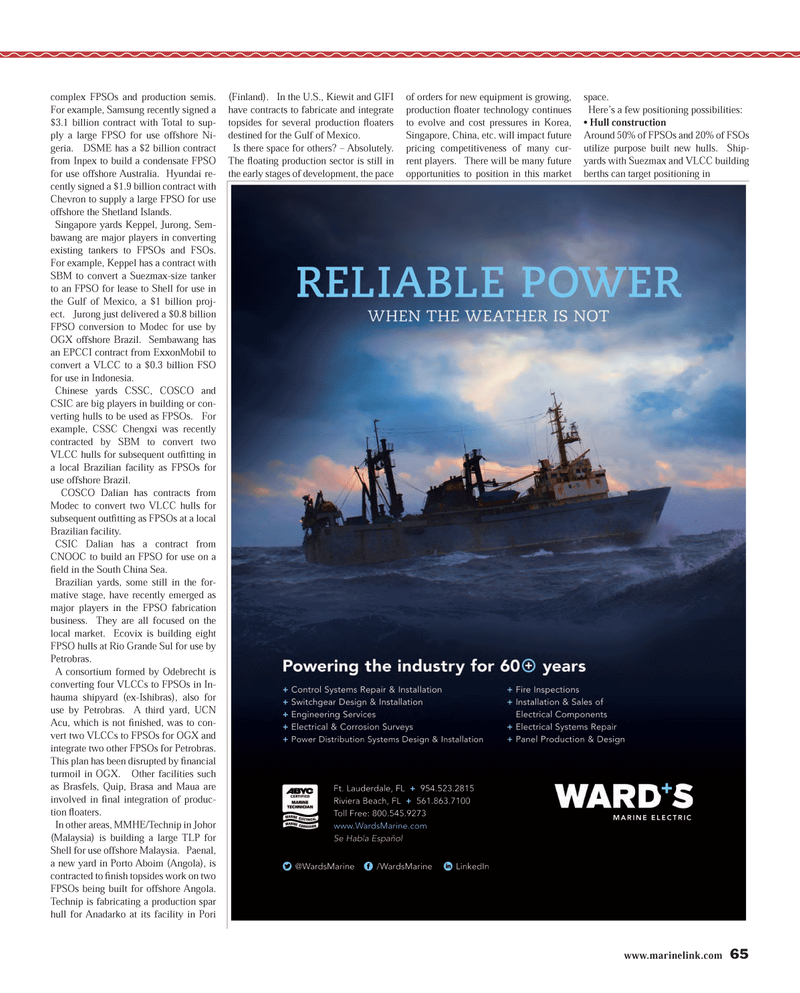
Page 65: of Maritime Reporter Magazine (September 2013)
Workboat Annual
Read this page in Pdf, Flash or Html5 edition of September 2013 Maritime Reporter Magazine
www.marinelink.com 65complex FPSOs and production semis. For example, Samsung recently signed a $3.1 billion contract with Total to sup- ply a large FPSO for use offshore Ni- geria. DSME has a $2 billion contract from Inpex to build a condensate FPSO for use offshore Australia. Hyundai re- cently signed a $1.9 billion contract with Chevron to supply a large FPSO for use offshore the Shetland Islands. Singapore yards Keppel, Jurong, Sem-bawang are major players in converting existing tankers to FPSOs and FSOs. For example, Keppel has a contract with SBM to convert a Suezmax-size tanker to an FPSO for lease to Shell for use in the Gulf of Mexico, a $1 billion proj-ect. Jurong just delivered a $0.8 billion FPSO conversion to Modec for use by OGX offshore Brazil. Sembawang has an EPCCI contract from ExxonMobil to convert a VLCC to a $0.3 billion FSO for use in Indonesia.Chinese yards CSSC, COSCO and CSIC are big players in building or con-verting hulls to be used as FPSOs. For example, CSSC Chengxi was recently contracted by SBM to convert two VLCC hulls for subsequent outÞ tting in a local Brazilian facility as FPSOs for use offshore Brazil. COSCO Dalian has contracts from Modec to convert two VLCC hulls for subsequent outÞ tting as FPSOs at a local Brazilian facility. CSIC Dalian has a contract from CNOOC to build an FPSO for use on a Þ eld in the South China Sea. Brazilian yards, some still in the for- mative stage, have recently emerged as major players in the FPSO fabrication business. They are all focused on the local market. Ecovix is building eight FPSO hulls at Rio Grande Sul for use by Petrobras. A consortium formed by Odebrecht is converting four VLCCs to FPSOs in In- hauma shipyard (ex-Ishibras), also for use by Petrobras. A third yard, UCN Acu, which is not Þ nished, was to con- vert two VLCCs to FPSOs for OGX and integrate two other FPSOs for Petrobras. This plan has been disrupted by Þ nancial turmoil in OGX. Other facilities such as Brasfels, Quip, Brasa and Maua are involved in Þ nal integration of produc- tion ß oaters.In other areas, MMHE/Technip in Johor (Malaysia) is building a large TLP for Shell for use offshore Malaysia. Paenal, a new yard in Porto Aboim (Angola), is contracted to Þ nish topsides work on two FPSOs being built for offshore Angola. Technip is fabricating a production spar hull for Anadarko at its facility in Pori (Finland). In the U.S., Kiewit and GIFI have contracts to fabricate and integrate topsides for several production ß oaters destined for the Gulf of Mexico.Is there space for others? ? Absolutely. The ß oating production sector is still in the early stages of development, the pace of orders for new equipment is growing, production ß oater technology continues to evolve and cost pressures in Korea, Singapore, China, etc. will impact future pricing competitiveness of many cur- rent players. There will be many future opportunities to position in this market space. Here?s a few positioning possibilities: ? Hull construction Around 50% of FPSOs and 20% of FSOs utilize purpose built new hulls. Ship-yards with Suezmax and VLCC building berths can target positioning in MR #9 (58-65).indd 65MR #9 (58-65).indd 658/30/2013 10:09:51 AM8/30/2013 10:09:51 AM

 64
64

 66
66
